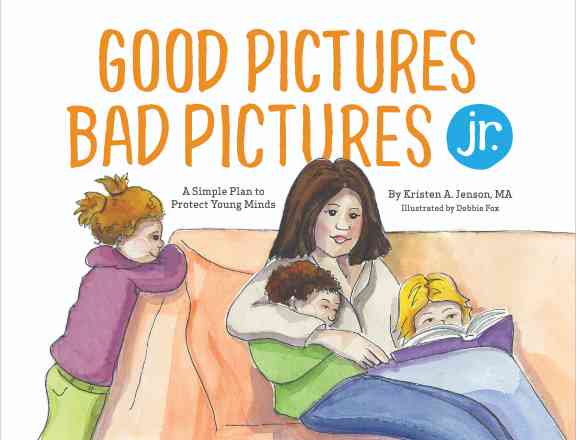
11 Safe Video Chat Rules You Need to Teach Your Kids
Imagine that your kids could use video chat to build close relationships with far-away loved ones - like their grandparents and their best friend who moved away. And at the same time they knew how to be safe from all the dangerous people and situations that can happen on video chat!

Keep reading for 11 rules to talk about with your kids. These guidelines are going to help them enjoy the benefits and avoid the risks of video chat!
Our wake-up call
Our family rule has always been, “No boys in your room.” Before my oldest daughter started dating, this wasn’t something we gave much deep thought about - until we realized that Facetime was, in some ways, like allowing a boy in her bedroom. Suddenly, it was time to talk about rules for safe video chat for kids.
It hit us—the visual interaction added to those private phone conversations opens up a whole host of potential pitfalls. We quickly realized the need for some frank conversations with our daughter.
Today, video chatting is commonplace. It’s available on many platforms and is a routine way to communicate. It’s time to educate our kids so they are ready for situations they may not anticipate themselves.
Since you can’t actually touch someone over video chat, it may seem safer than actually hanging out in person. In some ways, this is true. However, it’s important to think through the possibilities and help your child establish healthy boundaries for video calls.
Video chatting: where the online and real worlds collide
A good place to start is with the rules you already have in place. Video chatting is subject to whatever digital media guidelines you have in your family. And the same family standards for “real life” behavior also go for video calling. (If you need ideas for agreements, check out these from Fight the New Drug and Better Screen Time.)
Be clear about expectations that are specific to video chatting. Lay down rules such as what time of day video chatting is allowed, who they can chat with, when a parent needs to be present, etc. And be clear that the rules can be expanded over time as you learn more and have new experiences.
Here are some tips and tools for safe video chat for kids:
1. Define your dress code
The dress code when video chatting is the same as in person. Kids don’t always think through this one. They know their parents would never let them go out in a sports bra and running tights. But if they are used to hanging out at home that way, they may not recognize that what they’re wearing is inappropriate when they answer a Facetime call.
2. Beware too much privacy
If you wouldn’t leave two people alone behind a closed door, then the same goes for video calls. Kids may feel “safer” trying something over chat (i.e. revealing body parts or getting into suggestive conversations) than they would if they were actually face-to-face in person.
3. No chat in overly intimate spaces
There’s something sacred about a bedroom. It’s a personal haven and a reflection of who you are and what you like. To allow someone in your bedroom means you feel safe around them. But if you wouldn’t feel safe with this person in your child’s bedroom, it isn’t a good idea to allow video chat in there either. This may not be a line your child understands, since she or he has grown up with these types of devices around the house.
[[CTA]]
4. Remember that everything can be recorded and shared
Video chats can be recorded and screen-shot - often without the other person knowing. This means that even though it seems like a private conversation, it could end up viewed by far more than just one other person. Remind your children to be aware of this, and never say or do anything on video that they wouldn’t be comfortable with others seeing.
5. Respect others’ wishes
Kids may get so comfortable video chatting that they turn the camera on others without considering how they feel about it. Make sure to ask permission to include others in a video chat (i.e. at a sleepover when other kids may be in their PJs). Some people, young or old, may not want to talk or be shown on video. Kids should respect others’ privacy without question and never push friends to do something they don’t want to on video.
6. Don’t fall into a false sense of safety with familiar people
We may relax when “It’s just Uncle Bob” or “It’s just her soccer coach.” But we need to set rules to protect our children when they may be very naive and trusting. Be mindful of any one-on-one chatting taking place between your child and an adult. The scary fact is 90% of victims know their abuser. Many predators know exactly how to make the child feel safe with him/her and they can easily fool us, too. Children should only video chat with other adults when we are there to listen in.
Know how teachers, coaches, and youth group leaders are communicating with your kids. There are fantastic tools that provide necessary boundaries between kids and adults. The Remind app keeps both the adult's and child's phone numbers private. GroupMe is a great way to keep communication in a group setting rather than one-on-one.
Share on Pinterest

7. Watch out for predators luring kids from gaming to one-on-one video chat
There are so many games where kids can connect and play with a virtual team. With only user names to identify them, it’s impossible to know who the real person behind the controller actually is.
While they are often other kids, beware - they can also be predators who know exactly what to say to lure your child. TeenSafe reports that
“Predators will most likely start off a conversation with an innocent question about the child’s name or age, and then move into more inappropriate questions as the relationship grows. After contact has been initiated, the predator may try to convince the child to take the conversation over to another app such as WhatsApp, Skype or Snapchat.”
Become knowledgeable about grooming and the warning signs that your child may have been lured into dangerous chats both inside and outside the game.
8. Sextortion is rising dramatically
Through video chats, predators entice kids into sending compromising pictures of themselves. Then the kids are threatened with exposure if they don’t send more. It’s not just happening with older teens. In fact, 1 in 4 known victims were 12 or under when they were threatened.
9. Don't accept video chat requests from people you don’t know.
Not ever. Not even once. Enough said.
10. Put parental controls to work for you
Leave personal details out of video chat profiles, since some profiles are public. Know how to set privacy settings in any video chat apps. For example, if you use Skype, you can make your child undiscoverable. On an iPhone, you can turn off and restrict Facetime and allow it only when you’re present.
You can learn more about specific video chat apps from Zift App Advisor.
Also, consider using video apps designed for kids such as Facebook Messenger Kids or JusTalk Kids Video Chat App that might be more kid-friendly. No app is fool-proof, so be sure to keep following all these guidelines no matter what app kids are using.
11. Prepare kids for the worst-case scenario.
Just as we train young drivers what to do if they begin hydroplaning, kids need to know what to do if someone sends them an inappropriate picture, asks for personal information or behaves in ways that make them uncomfortable. Practice how to refuse grooming behaviors. Plan together how they can tell you whenever they have had an unsettling experience.
Positive plusses despite potential pitfalls
After all this, you may be tempted to never allow any kind of video chatting ever with your kids. But the fact is, video calls can be a fun and rewarding way to deepen healthy relationships.
Video chats allow kids to see their grandparents and other relatives more frequently than they normally would. My girls have enjoyed doing makeup tutorials with their friends, asking for clothing advice, and engaging in some great heart-to-heart conversations. Sometimes just seeing a friendly face helps us to feel far less alone during trying times and this goes for kids, too.
Encourage good digital citizenship! Just as we teach our children to behave in public, we need to teach them appropriate online behavior, too. This means discussing both positive and negative actions.
Ask your kids these questions:
- What are some positive things about video chatting?
- When is it fun to use?
- Who are some people in our lives that make life better when we video chat with them?
- What are some ways we can show others respect while video chatting?
These are broad questions that will elicit many types of answers. Most importantly they will get your family talking about communicating via video chat in the best ways.
Conclusion - working toward safe video chat for kids
With any technology, there are upsides and downsides to video chatting. As always, your most powerful weapon is open communication with your kids. Be a safe place, establish clear boundaries, and stay engaged with your kids - you can use video chatting in positive ways in your home.



Good Pictures Bad Pictures Jr.
“I highly recommend this book to all people with children. A must have for all parents!” —Amazon Review







